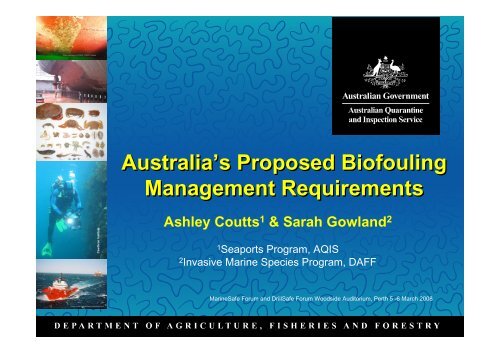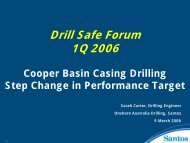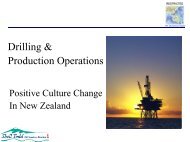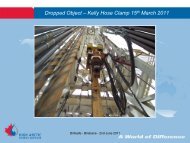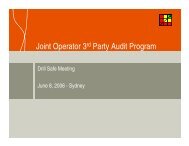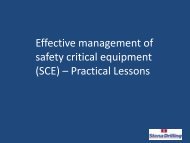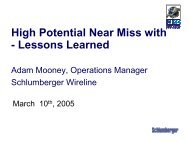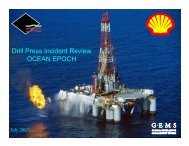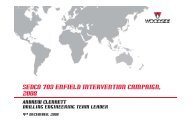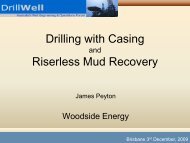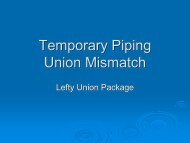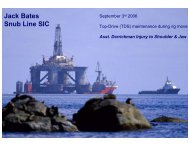Australia's Proposed Biofouling Management Requirements Australia ...
Australia's Proposed Biofouling Management Requirements Australia ...
Australia's Proposed Biofouling Management Requirements Australia ...
You also want an ePaper? Increase the reach of your titles
YUMPU automatically turns print PDFs into web optimized ePapers that Google loves.
Photo courtesy of CRIMP, CSIRO, Hobart<br />
<strong>Australia</strong>’s <strong>Proposed</strong> <strong>Biofouling</strong><br />
<strong>Management</strong> <strong>Requirements</strong><br />
Cawthron Institute<br />
Ashley Coutts 1 & Sarah Gowland 2<br />
1<br />
Seaports Program, AQIS<br />
2<br />
Invasive Marine Species Program, DAFF<br />
MarineSafe Forum and DrillSafe Forum Woodside Auditorium, Perth 5 -6 March 2008
Marine pests – the problem
Inter-Governmental Agreement<br />
• Inter-Governmental Agreement (IGA) on a National<br />
System for the Prevention and <strong>Management</strong> of<br />
Marine Pest Incursions<br />
1). Prevention<br />
2). Emergency Response<br />
3). On-going <strong>Management</strong> and Control
Intergovernmental Agreement<br />
• The IGA provides that the <strong>Australia</strong>n Government,<br />
through legislation:<br />
“will ensure that vessels entering <strong>Australia</strong> are<br />
subject to agreed measures to minimise the risk of<br />
introducing marine pests through biofouling”
Vessel visits - 2007<br />
Vessel type/category<br />
Number of visits<br />
Commercial vessels (Merchant vessels) 11,670<br />
Yachts (< 25 metres in length) 704<br />
Non-trading vessels (e.g., dredges, tug boats, barges,<br />
petroleum industry infrastructure, research vessels, etc) 346<br />
Cruise vessels 140<br />
Royal <strong>Australia</strong>n Navy 116<br />
Apprehended foreign fishing vessels 109<br />
Foreign Navy 66<br />
Commercial fishing vessels 32<br />
Super yachts 28<br />
Total 13,211<br />
Source: AQIS Vessel Monitoring System (VMS)
Translocation process & risk factors<br />
Donor region<br />
1. COLONISATION<br />
2. TRANSLOCATION<br />
• Presence/absence of anti-fouling coatings<br />
• Age of anti-fouling coatings<br />
• Type of anti-fouling coating<br />
• Hull location<br />
• Residency period (inshore waters)<br />
• Type of anti-fouling coating<br />
• Voyage speed<br />
• Voyage duration<br />
• Voyage route<br />
• Hull location<br />
Recipient region<br />
3. TRANSFER<br />
4. COLONISATION<br />
5. ESTABLISHMENT<br />
• Residency period (inshore waters)<br />
• Hull location<br />
• Defouling activity (e.g., in-water cleaning)<br />
• Availability of suitable substrate<br />
• Biotic resistance<br />
• Water currents, etc<br />
• Environmental conditions<br />
• Availability of suitable substrate<br />
• Further inoculations<br />
• Predation, etc
Hazard analysis – vessel classes<br />
Vessel Category<br />
Scientific<br />
evidence<br />
Anti-fouling<br />
coating<br />
Residency<br />
period<br />
Transit<br />
speed<br />
Hazard<br />
rating<br />
Apprehended IFFVs<br />
and abandoned vessels<br />
High High High High High<br />
Yachts Moderate High High High High<br />
Non-trading vessels High High High High High<br />
Petroleum production<br />
and exploration<br />
industry<br />
Commercial fishing<br />
vessels<br />
Moderate High Moderate High Moderate<br />
Moderate Moderate Moderate Moderate Moderate<br />
Commercial vessels Moderate Low Low Low Low<br />
Naval vessels Moderate Low Low Low Low
Non-trading vessels<br />
• Barges and Lighters<br />
• Coastal patrol vessels<br />
• Dredges<br />
• Heavy-lift vessels<br />
• Oil recovery vessels<br />
• Pipe laying vessels<br />
• Patrol boats<br />
• Research vessels<br />
• Semi-submersible<br />
heavy-lift vessels<br />
• Super yachts (> 25 m)<br />
• Tall ships<br />
• Tugs and Line handling<br />
vessels
Hazard analysis – vessel classes<br />
Vessel Category<br />
Scientific<br />
evidence<br />
Anti-fouling<br />
coating<br />
Residency<br />
period<br />
Transit<br />
speed<br />
Hazard<br />
rating<br />
Apprehended IFFVs<br />
and abandoned vessels<br />
High High High High High<br />
Yachts Moderate High High High High<br />
Non-trading vessels High High High High High<br />
Petroleum production<br />
and exploration<br />
industry<br />
Commercial fishing<br />
vessels<br />
Moderate High Moderate High Moderate<br />
Moderate Moderate Moderate Moderate Moderate<br />
Commercial vessels Moderate Low Low Low Low<br />
Naval vessels Moderate Low Low Low Low
Petroleum Production and<br />
Exploratory Industry Vessels<br />
• Mobile Offshore Drilling Units (MODUs) including: Drillships/vessels,<br />
Jack-up rigs, Submersible and Semisubmersible<br />
rigs<br />
• Floating Production, Storage and Offloading Vessels<br />
(FSO, FPSO)<br />
• Seismic survey vessels<br />
• Offshore Support Vessels (OSV) including: Utility<br />
Support Vessels (USV); Platform Supply Vessels (PSV);<br />
Anchor Handing Tug Supply Vessels (AHTSV); Crew<br />
Transfer Vessels (CTV); Diving Support Vessels (DSV);<br />
Accommodation Vessels.
Hazard analysis – vessel classes<br />
Vessel Category<br />
Scientific<br />
evidence<br />
Anti-fouling<br />
coating<br />
Residency<br />
period<br />
Transit<br />
speed<br />
Hazard<br />
rating<br />
Apprehended IFFVs<br />
and abandoned vessels<br />
High High High High High<br />
Yachts Moderate High High High High<br />
Non-trading vessels High High High High High<br />
Petroleum production<br />
and exploration<br />
industry<br />
Commercial fishing<br />
vessels<br />
Moderate High Moderate High Moderate<br />
Moderate Moderate Moderate Moderate Moderate<br />
Commercial vessels Moderate Low Low Low Low<br />
Naval vessels Moderate Low Low Low Low
<strong>Biofouling</strong> <strong>Management</strong> Approach<br />
Hazard Analysis of Vessel Classes<br />
Low risk Moderate/ High risk<br />
<strong>Biofouling</strong> <strong>Management</strong> <strong>Requirements</strong><br />
Risk<br />
Assessment<br />
National Best Practice<br />
<strong>Biofouling</strong> <strong>Management</strong><br />
Guidelines<br />
Potential high risk<br />
vessel reported to AQIS<br />
Low risk<br />
Moderate/<br />
High risk<br />
In-water<br />
inspection<br />
Low risk<br />
Moderate/<br />
High risk<br />
Pratique granted<br />
Treatment<br />
Pratique declined
Quarantine Powers<br />
• Quarantine Act 1908<br />
• Quarantine Regulations 2000<br />
• Quarantine Proclamation 1998<br />
• Section 78A<br />
– Section 78A provides for the giving of a treatment<br />
direction where a quarantine officer believes, on<br />
reasonable grounds, that the vessel or<br />
installation is in an ‘insanitary condition’, or is<br />
‘likely’ to be carrying diseases or pests of<br />
quarantinable concern.
<strong>Biofouling</strong> <strong>Management</strong> <strong>Requirements</strong><br />
• Proclaimed quarantinable pests<br />
– Consultative Committee on Introduced Marine Pest<br />
Emergencies (CCIMPE) marine pest ‘trigger list’<br />
• Selection criteria<br />
– Capable of being translocated as a biofouling<br />
organism<br />
– Detectable on a vessel during inspection<br />
– Recognisable in the field by a quarantine officer<br />
– Non-indigenous (non-established) species
Proclaimed species<br />
No. Genus/species<br />
Common name<br />
1 Eriocheir sinensis Chinese mitten crab<br />
2 Hemigrapsus sanguineus Japanese/Asian shore crab<br />
3 Crepidula fornicata American slipper limpet<br />
4 Mytilopsis sallei Black striped mussel<br />
5 Perna viridis Asian green mussel<br />
6 Perna perna Brown mussel<br />
7 Corbula (Potamocorbula) amurensis Asian clam<br />
8 Rapana venosa Rapa Whelk<br />
9 Didemnum vexillum Colonial sea squirt<br />
10 Sargassum muticum Asian seaweed<br />
11 Mya arenaria Soft shell clam<br />
12 Ensis directus Jack-knife clam<br />
13 Hemigrapsus takanoi/penicillatus Pacific crab<br />
14 Charybdis japonica Lady crab
<strong>Biofouling</strong> <strong>Management</strong> Approach<br />
Hazard Analysis of Vessel Classes<br />
Low risk Moderate/ High risk<br />
<strong>Biofouling</strong> <strong>Management</strong> <strong>Requirements</strong><br />
Risk<br />
Assessment<br />
National Best Practice<br />
<strong>Biofouling</strong> <strong>Management</strong><br />
Guidelines<br />
Potential high risk<br />
vessel reported to AQIS<br />
Low risk<br />
Moderate/<br />
High risk<br />
In-water<br />
inspection<br />
Low risk<br />
Moderate/<br />
High risk<br />
Pratique granted<br />
Treatment<br />
Pratique declined
On-arrival biofouling risk assessment<br />
1). Does the vessel possess a new or current antifouling<br />
coating?<br />
2). Has the vessel’s hull been inspected and cleaned<br />
(out of water or in-water), including all niche areas<br />
immediately prior to arrival to <strong>Australia</strong>?<br />
3). Has the vessel remained in overseas inshore waters<br />
for less than 31 consecutive days after being<br />
inspected and cleaned?<br />
4). Is there authentic documentation available to<br />
support the above?
<strong>Biofouling</strong> <strong>Management</strong> Approach<br />
Hazard Analysis of Vessel Classes<br />
Low risk Moderate/ High risk<br />
<strong>Biofouling</strong> <strong>Management</strong> <strong>Requirements</strong><br />
Risk<br />
Assessment<br />
National Best Practice<br />
<strong>Biofouling</strong> <strong>Management</strong><br />
Guidelines<br />
Potential high risk<br />
vessel reported to AQIS<br />
Low risk<br />
Moderate/<br />
High risk<br />
In-water<br />
inspection<br />
Low risk<br />
Moderate/<br />
High risk<br />
Pratique granted<br />
Treatment<br />
Pratique declined
<strong>Biofouling</strong> succession process<br />
Primary Secondary Tertiary<br />
Vessel’s immersion<br />
(e.g., release from dry-dock)<br />
- Slime<br />
- Microalgae<br />
- Filamentous algae<br />
- Acorn barnacles<br />
- Gooseneck<br />
barnacles<br />
- Bryozoans<br />
-Hydroids<br />
- Serpulids<br />
- Spirorbids<br />
- Algal tuffs<br />
- Coralline algae<br />
- Amphipods<br />
- Sponges<br />
- Ascidians<br />
- Mussels<br />
- Oysters<br />
-Clams<br />
- Gastropods<br />
-Crabs, shrimps<br />
-Starfish<br />
- Sabellid worms<br />
- Sea anemones<br />
- Large macroalgae<br />
Vessel’s removal<br />
(e.g., dry-docking)
Primary biofouling
Secondary biofouling
Tertiary biofouling
Inspections will target niche areas<br />
Super-structure<br />
Propellers &<br />
Rope Guards<br />
Bilge keels<br />
Anodes<br />
Rudders<br />
Bulbous bows<br />
Bow thrusters<br />
Dry docking support strips<br />
Sea-chests/internal<br />
seawater systems
<strong>Biofouling</strong> <strong>Management</strong> Approach<br />
Hazard Analysis of Vessel Classes<br />
Low risk Moderate/ High risk<br />
<strong>Biofouling</strong> <strong>Management</strong> <strong>Requirements</strong><br />
Risk<br />
Assessment<br />
National Best Practice<br />
<strong>Biofouling</strong> <strong>Management</strong><br />
Guidelines<br />
Potential high risk<br />
vessel reported to AQIS<br />
Low risk<br />
Moderate/<br />
High risk<br />
In-water<br />
inspection<br />
Low risk<br />
Moderate/<br />
High risk<br />
Pratique granted<br />
Treatment<br />
Pratique declined
<strong>Proposed</strong> Area of Operation in <strong>Australia</strong>n Waters<br />
Consider AQIS’ On-arrival <strong>Biofouling</strong> Risk<br />
Pre-arrival biofouling risk assessment<br />
Assessment Criteria<br />
1). Does the vessel possess a new or current anti-fouling coating? 1<br />
Offshore Waters<br />
Inshore Waters<br />
2). Has the vessel’s hull been inspected and cleaned (out of the water or in-<br />
(Only)<br />
(Anytime)<br />
water), including all niche areas immediately prior to arrival to <strong>Australia</strong>?<br />
(Greater than 12 nm<br />
(Less than 12 nm from<br />
from land and greater<br />
land)<br />
3). Has the vessel remained in overseas inshore Inshore<br />
waters for more than 31<br />
than 50 m depth of<br />
consecutive days after being inspected and cleaned?<br />
water)<br />
4). Is there authentic documentation available to support the above?<br />
Pre-arrival <strong>Biofouling</strong> Mitigation Options<br />
Option 1: Remove vessel<br />
from the water with an<br />
AQIS approved service<br />
provider present<br />
• Clean the entire submerged<br />
area of the vessel, including<br />
all niche areas<br />
• If necessary, renew antifouling<br />
coating<br />
• Collect and retain authentic<br />
supporting documentation<br />
• Depart for <strong>Australia</strong> as soon<br />
as possible, but no greater<br />
than 31 days after being<br />
released back into the water<br />
• Travel directly to <strong>Australia</strong><br />
Option 2: In-water<br />
inspection with an AQIS<br />
approved service provider<br />
present<br />
• Inspect and clean (if<br />
necessary) the entire<br />
submerged area of the<br />
vessel, including all niche<br />
areas<br />
• Collect and retain authentic<br />
supporting documentation<br />
• Depart for <strong>Australia</strong> as soon<br />
as possible, but no greater<br />
than 31 days after being<br />
inspected and cleaned<br />
• Travel directly to <strong>Australia</strong><br />
Option 3: Remove vessel<br />
from the water without an<br />
AQIS approved service<br />
provider present<br />
• Clean the entire submerged<br />
area of the vessel, including<br />
all niche areas<br />
• If necessary, renew antifouling<br />
coating<br />
• Collect and retain authentic<br />
supporting documentation<br />
• Depart for <strong>Australia</strong> as soon<br />
as possible, but no greater<br />
than 31 days after being<br />
released back into the water<br />
• Travel directly to <strong>Australia</strong><br />
Option 4: In-water<br />
inspection without an<br />
AQIS approved service<br />
provider present<br />
• Inspect and clean (if<br />
necessary) the entire<br />
submerged area of the<br />
vessel, including all niche<br />
areas<br />
• Collect and retain authentic<br />
supporting documentation<br />
• Depart for <strong>Australia</strong> as soon<br />
as possible, but no greater<br />
than 31 days after being<br />
inspected and cleaned<br />
• Travel directly to <strong>Australia</strong><br />
Option 5:<br />
No pre-arrival<br />
biofouling<br />
mitigation<br />
undertaken<br />
AQIS On-arrival <strong>Biofouling</strong> Risk Assessment<br />
Unlikely<br />
Likelihood of an in-water inspection<br />
Possible<br />
Likely
State and Territory Regulations<br />
Western <strong>Australia</strong><br />
• Department of Fisheries<br />
– Fish Resources <strong>Management</strong> Act 1994<br />
– Fish Resources <strong>Management</strong> Regulations 1995<br />
• Department of Environment and Conservation<br />
– Ministerial Conditions<br />
– Environment Protection Act 1986<br />
• Port Authorities<br />
– Port Authorities Act 1999<br />
– Port Authority Regulations 2001
Further information<br />
• Communications – proposed late<br />
March 2008<br />
• Implementation – proposed 1 July<br />
2008<br />
• International Maritime Organization
International Maritime Organisation<br />
• IMO Paper (April 2007):<br />
– Marine Environment Protection Committee (MEPC) (56/19/3)<br />
– “Development of international measures for minimising the<br />
translocation of invasive aquatic species through biofouling of ships”<br />
– New Zealand, <strong>Australia</strong>, UK, Friend of the Earth International, and<br />
the World Conservation Union<br />
• Outcome (July 2007):<br />
– Committee approved the inclusion of a new high priority item in the<br />
Sub-committee on Bulk Liquids and Gases (BLG)<br />
• 12th Session of the sub-committee on BLG (February 2008)<br />
– BLG 12/11 paper (<strong>Australia</strong> and New Zealand)<br />
– BLG 12/11/2 paper (New Zealand and UK) implementation options<br />
– Sub-committee agreed to establish a Correspondence Group
Other countries<br />
• United States: State of California<br />
− Assembly Bill No. 740<br />
− Vessels > 300 GWT<br />
− Mandatory reporting – 1 January 2008<br />
− <strong>Biofouling</strong> <strong>Requirements</strong> 1 January 2012<br />
• New Zealand<br />
− In the process
Any Questions…….


